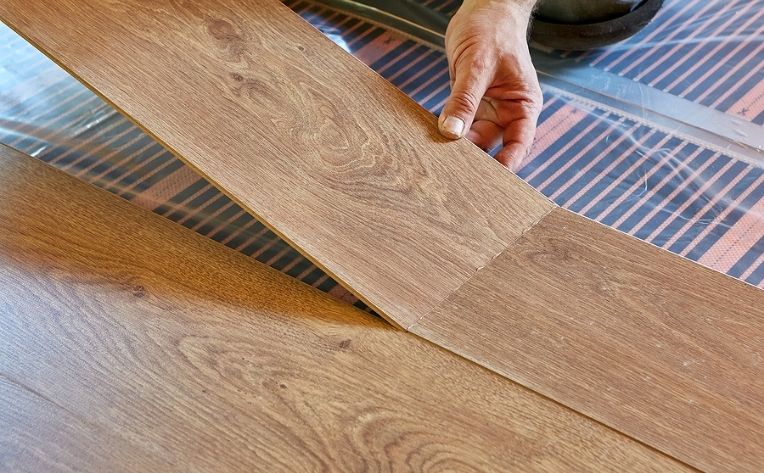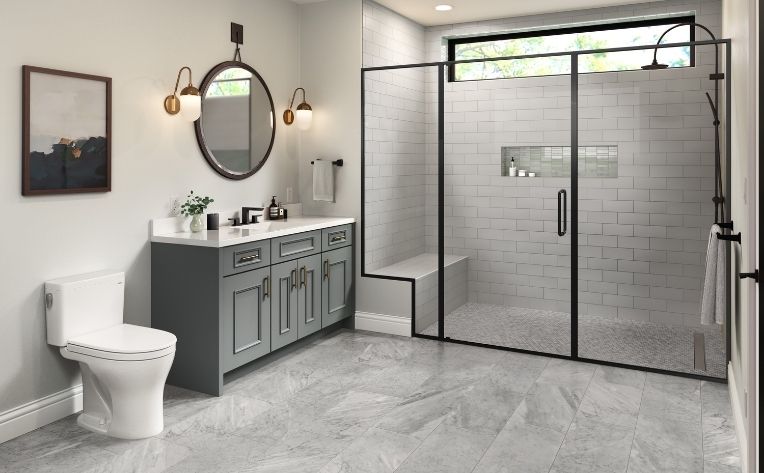Sep 28, 2021 | Flooring Canada

Electric-heated floor systems are typically used in areas of the home where a traditional heating system, like an HVAC unit, can’t reach or on a surface that is normally cool to the touch. These work off of radiant heating, similar to how you can feel when the stovetop is turned on even when you’re across the room. The idea is simple: rather than having a forced-air vent in a room that will determine which part of the room is the warmest, you can warm the whole room evenly through radiant heat on the floor.
Typically, you’ll find electric-heated floor systems in bathrooms since you’re barefoot most of the time you’re in there. And who wants to step out of a nice warm shower onto a freezing cold floor anyway? It’s nearly impossible to retroactively install an electric-heated floor system into an existing floor, so almost always, a new floor must be installed over the top of the heating system.

Radiant floor heating isn’t a new idea. It actually dates all the way back to ancient Rome, where beneath the elevated marble floors of certain buildings was a system of tunnels that circulated air heated by fires. But it has certainly come a long way since then.
Nowadays, to heat a floor electrically, thin cables are installed under the surface of the floor. In some systems, these wires are grouped in mats that roll out easily across the subfloor. In others, individual wires are spaced and adhered directly to the subfloor. If your flooring includes an underlayment, the heating elements will be installed on top of that as well. In both cases, heat is produced as an electrical charge that moves through these wires. These systems are most often controlled by their own thermostat.
While any type of flooring material can cover an electric-heated floor, some are more effective than others. Because they conduct heat and it won’t warp or damage them, ceramic, stone, and porcelain tiles are the most common types of heated floors you’ll find. Alternatively, installing a heating system under wood floors can be trickier as it can affect the moisture content of the wood, leading to cracks and gaps. If you are looking to install a heating element under your hardwood floors, be sure to talk to a flooring expert at your local Flooring America.
Laminate flooring already has the benefit of feeling warm underfoot because of the wood content of the base layer and typically an underlayment. So, installing a heating system under a laminate floor should really only be reserved for rooms that are very cold. Like laminate, vinyl flooring can easily conduct warmth from a floor heating system because it tends to be thinner, but there are some things to look out for.
Whenever installing an electric-heated floor system, be sure to check your flooring warranty to verify the max temperature limit. Not only will going over the temperature limit void your warranty, but it could also damage floors made from wood, vinyl, or laminate. Most of the time, electric-heated floor systems are not paired with carpets since the carpet is already such a good insulator, and it reduces the amount of heat that is able to travel through it to your feet and the rest of the room. Remember, the more insulators (i.e., rugs and furniture) you place on top of the heating elements; the less heat will transfer easily into the room.

There are even a few less common flooring materials that should never have an electric-heated floor system installed, like rubber flooring, concrete flooring, and any flooring that is joined by adhesive, as the shifts in temperature may cause the adhesive to corrode faster.
Overall, electric-heated floor systems are a great way to provide most rooms with rich heat in a quiet, sometimes more energy-efficient way. While electric heat is expensive, the thermostat allows you to control the temperature, so you’re not wasting as much energy as some traditional heating methods. If you need help answering any other questions about radiant floor heating, talk to your local flooring expert at your nearest Flooring America. Check to make sure your flooring choice is radiant-heat approved.